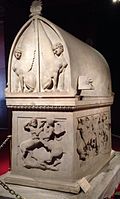
Lycia was a state or nationality that flourished in Anatolia from 15–14th centuries BC to 546 BC. It bordered the Mediterranean Sea in what is today the provinces of Antalya and Muğla in Turkey as well some inland parts of Burdur Province. The state was known to history from the Late Bronze Age records of ancient Egypt and the Hittite Empire. Lycia was populated by speakers of the Luwian language group. Written records began to be inscribed in stone in the Lycian language after Lycia's involuntary incorporation into the Achaemenid Empire in the Iron Age. At that time (546 BC) the Luwian speakers were displaced as Lycia received an influx of Persian speakers. Ancient sources seem to indicate that an older name of the region was Alope.

Xanthos or Xanthus, also referred to by scholars as Arna, its Lycian name, was an ancient city near the present-day village of Kınık, in Antalya Province, Turkey. The ruins are located on a hill on the left bank of the River Xanthos. The number and quality of the surviving tombs at Xanthos are a notable feature of the site, which, together with nearby Letoon, was declared to be a UNESCO World Heritage Site in 1988.

Mausolus was a ruler of Caria and a satrap of the Achaemenid Empire. He enjoyed the status of king or dynast by virtue of the powerful position created by his father Hecatomnus, who was the first satrap of Caria from the hereditary Hecatomnid dynasty. Alongside Caria, Mausolus also ruled Lycia and parts of Ionia and the Dodecanese islands. He is best known for his monumental tomb and one of the Seven Wonders of the Ancient World, the Mausoleum at Halicarnassus, the construction of which has traditionally been ascribed to his wife and sister Artemisia.

The Anatolian languages are an extinct branch of Indo-European languages that were spoken in Anatolia, part of present-day Turkey. The best known Anatolian language is Hittite, which is considered the earliest-attested Indo-European language.

The Alexander Sarcophagus is a late 4th century BC Hellenistic stone sarcophagus from the necropolis near Sidon, Lebanon. It is adorned with bas-relief carvings of Alexander the Great and scrolling historical and mythological narratives. The work is considered to be remarkably well preserved, and has been used as an exemplar for its retention of polychromy. It is currently in the holdings of the Istanbul Archaeology Museum.

The study of Roman sculpture is complicated by its relation to Greek sculpture. Many examples of even the most famous Greek sculptures, such as the Apollo Belvedere and Barberini Faun, are known only from Roman Imperial or Hellenistic "copies". At one time, this imitation was taken by art historians as indicating a narrowness of the Roman artistic imagination, but, in the late 20th century, Roman art began to be reevaluated on its own terms: some impressions of the nature of Greek sculpture may in fact be based on Roman artistry.

The Istanbul Archaeology Museums are a group of three archaeological museums located in the Eminönü quarter of Istanbul, Turkey, near Gülhane Park and Topkapı Palace.

A necropolis is a large, designed cemetery with elaborate tomb monuments. The name stems from the Ancient Greek νεκρόπολις nekropolis, literally meaning "city of the dead".
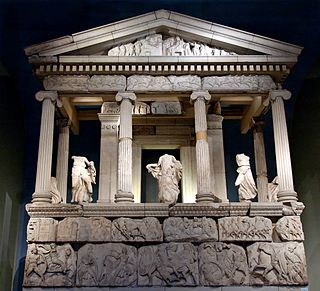
The Nereid Monument is a sculptured tomb from Xanthos in Lycia, close to present-day Fethiye in Mugla Province, Turkey. It took the form of a Greek temple on top of a base decorated with sculpted friezes, and is thought to have been built in the early fourth century BC as a tomb for Arbinas, the Xanthian dynast who ruled western Lycia under the Achaemenid Empire.

The Tomb of Payava is a Lycian tall rectangular free-standing barrel-vaulted stone sarcophagus, and one of the most famous tombs of Xanthos. It was built in the Achaemenid Persian Empire, for Payava, who was probably the ruler of Xanthos, Lycia at the time, in around 360 BC. The tomb was discovered in 1838 and brought to England in 1844 by the explorer Sir Charles Fellows. He described it as a 'Gothic-formed Horse Tomb'. According to Melanie Michailidis, though bearing a "Greek appearance", the Tomb of Payava, the Harpy Tomb and the Nereid Monument were built according to the main Zoroastrian criteria "by being composed of thick stone, raised on plinths off the ground, and having single windowless chambers".


Milas is an ancient city and the seat of the district of the same name in Muğla Province in southwestern Turkey. The city commands a region with an active economy and is very rich in history and ancient remains, the territory of Milas containing a remarkable twenty-seven archaeological sites of note. The city was the first capital of ancient Caria and of the Anatolian beylik of Menteşe in mediaeval times. The nearby Mausoleum of Hecatomnus is classified as a tentative UNESCO World Heritage Site.

The Achaemenid conquest of the Indus Valley refers to a process beginning in the 6th century BCE and ending in the 4th century BCE, whereby the Achaemenid Persian Empire established control over the northwestern regions of the Indian subcontinent, today predominantly comprising the territory of Pakistan. The first of the two main invasions was conducted around 535 BCE by Cyrus the Great, who annexed the areas to the west of the Indus River, consolidating the early eastern border of the Achaemenid Empire. With a brief pause after Cyrus' death, the campaign continued under Darius the Great, who began to re-conquer former provinces and further expand Persia's political boundaries. Around 518 BCE, Persian armies under Darius crossed the Himalayas into India to initiate a second period of conquest by annexing regions up to the Jhelum River in Punjab.

Ancient Greek art stands out among that of other ancient cultures for its development of naturalistic but idealized depictions of the human body, in which largely nude male figures were generally the focus of innovation. The rate of stylistic development between about 750 and 300 BC was remarkable by ancient standards, and in surviving works is best seen in sculpture. There were important innovations in painting, which have to be essentially reconstructed due to the lack of original survivals of quality, other than the distinct field of painted pottery.
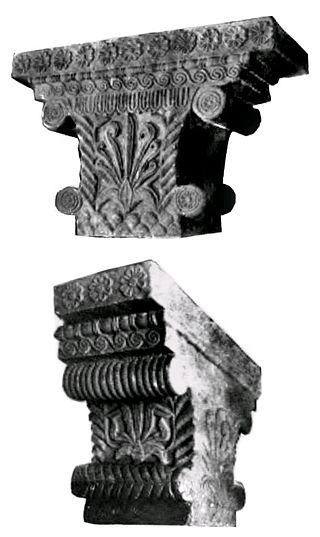
Hellenistic influence on Indian art and architecture reflects the artistic and architectural influence of the Greeks on Indian art following the conquests of Alexander the Great, from the end of the 4th century BCE to the first centuries of the common era. The Greeks in effect maintained a political presence at the doorstep, and sometimes within India, down to the 1st century CE with the Greco-Bactrian Kingdom and the Indo-Greek Kingdoms, with many noticeable influences on the arts of the Maurya Empire especially. Hellenistic influence on Indian art was also felt for several more centuries during the period of Greco-Buddhist art.

Xanthos, also called Xanthus, was a chief city state of the Lycians, an indigenous people of southwestern Anatolia. Many of the tombs at Xanthos are pillar tombs, formed of a stone burial chamber on top of a large stone pillar. The body would be placed in the top of the stone structure, elevating it above the landscape. The tombs are for men who ruled in a Lycian dynasty from the mid-6th century to the mid-4th century BCE and help to show the continuity of their power in the region. Not only do the tombs serve as a form of monumentalization to preserve the memory of the rulers, but they also reveal the adoption of Greek style of decoration.
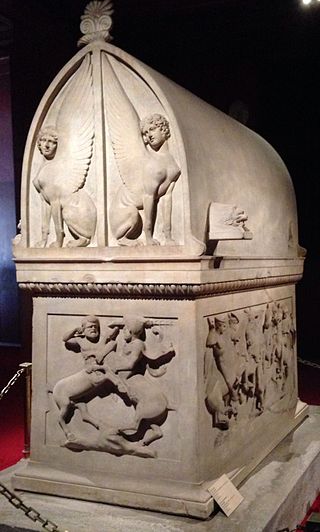
The Lycian sarcophagus of Sidon is a sarcophagus discovered in the Ayaa necropolis, in Sidon, Lebanon. It is made of Parian marble, and resembles the shapes of ogival Lycian tombs, hence its name. It is now located in the Istanbul Archaeological Museum. It is dated to circa 430-420 BC. This sarcophagus, as well as others in the Sidon necropolis, belonged to a succession of kings who ruled in the area of Phoenicia between the mid-5th century BC to the end of the 4th century BC.
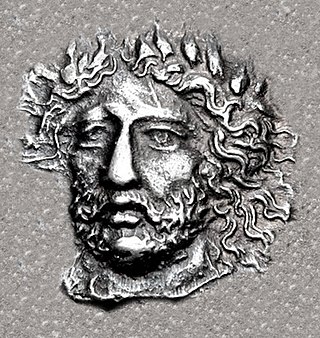
Perikles, was the last known independent dynast of Lycia. A dynast of Limyra in eastern Lycia c. 375–362 BCE, he eventually ruled the entire country during the Revolt of the Satraps, in defiance of the Achaemenid Empire.

The first Achaemenid conquest of Egypt took place in 525 BCE, leading to the foundation of the Twenty-seventh Dynasty of Egypt, also known as the "First Egyptian Satrapy". Egypt thus became a province (satrapy) of the Achaemenid Persian Empire until 404 BCE while still maintaining Egyptian royalty customs and positions. The conquest was led by Cambyses II, the King of Persia, who defeated the Egyptians at the Battle of Pelusium, and crowned himself as Pharaoh of Egypt. Achaemenid rule was disestablished upon the rebellion and crowning of Amyrtaeus as Pharaoh. A second period of Achaemenid rule in Egypt occurred under the Thirty-first Dynasty of Egypt.

The Gökçeler relief is an Achaemenid-era tomb relief made in the Anatolian-Persian style. It was found in 2004 in the village of Gökçeler in Manisa Province of present-day Turkey. The area of discovery corresponds to the northern part of the historic region of Lydia, at a time when it was a satrapy (province) of the Achaemenid Persian Empire. The relief is made out of limestone and measures 1.79m × 0.55m × 0.25m. The relief is a "distinctive product of the artistic synthesis classified as Graeco-Persian or Anatolian-Persian". It was created between the late 6th century and early 5th century BC. It may be used as "yet further evidence for the presence of Persians in the region".

